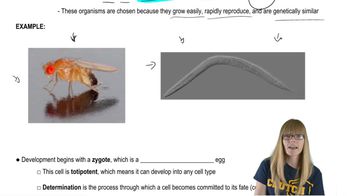Comparisons between human and chimpanzee genomes indicate that a gene that may function as a wild-type or normal gene in one primate may function as a disease-causing gene in another [The Chimpanzee Sequencing and Analysis Consortium (2005). Nature 437:69–87]. For instance, the PPARG locus (regulator of adipocyte differentiation) is a wild-type allele in chimps but is clearly associated with Type 2 diabetes in humans. What factors might cause this apparent contradiction? Would you consider such apparent contradictions to be rare or common? What impact might such findings have on the use of comparative genomics to identify and design therapies for disease-causing genes in humans?
Table of contents
- 1. Introduction to Genetics51m
- 2. Mendel's Laws of Inheritance3h 37m
- 3. Extensions to Mendelian Inheritance2h 41m
- 4. Genetic Mapping and Linkage2h 28m
- 5. Genetics of Bacteria and Viruses1h 21m
- 6. Chromosomal Variation1h 48m
- 7. DNA and Chromosome Structure56m
- 8. DNA Replication1h 10m
- 9. Mitosis and Meiosis1h 34m
- 10. Transcription1h 0m
- 11. Translation58m
- 12. Gene Regulation in Prokaryotes1h 19m
- 13. Gene Regulation in Eukaryotes44m
- 14. Genetic Control of Development44m
- 15. Genomes and Genomics1h 50m
- 16. Transposable Elements47m
- 17. Mutation, Repair, and Recombination1h 6m
- 18. Molecular Genetic Tools19m
- 19. Cancer Genetics29m
- 20. Quantitative Genetics1h 26m
- 21. Population Genetics50m
- 22. Evolutionary Genetics29m
15. Genomes and Genomics
Comparative Genomics
Problem 24a
Textbook Question
Dominguez et al. (2004) suggest that by studying genes that determine growth and tissue specification in the eye of Drosophila, much can be learned about human eye development.
What evidence suggests that genetic eye determinants in Drosophila are also found in humans? Include a discussion of orthologous genes in your answer.
 Verified step by step guidance
Verified step by step guidance1
Begin by defining orthologous genes: these are genes in different species that evolved from a common ancestral gene and typically retain the same function across species.
Explain that researchers have identified genes in Drosophila that control eye development, such as the 'eyeless' gene, which is crucial for eye formation in flies.
Discuss how the human ortholog of the Drosophila 'eyeless' gene is PAX6, a gene that also plays a key role in human eye development, indicating a conserved genetic mechanism.
Highlight experimental evidence where the Drosophila 'eyeless' gene can induce eye formation in other tissues, and similarly, human PAX6 can functionally substitute for 'eyeless' in flies, demonstrating functional conservation.
Conclude that the presence of orthologous genes like 'eyeless' and PAX6, along with their conserved roles in eye development, provides strong evidence that genetic determinants of eye formation are shared between Drosophila and humans.
 Verified video answer for a similar problem:
Verified video answer for a similar problem:This video solution was recommended by our tutors as helpful for the problem above
Video duration:
45sPlay a video:
Was this helpful?
Key Concepts
Here are the essential concepts you must grasp in order to answer the question correctly.
Orthologous Genes
Orthologous genes are genes in different species that evolved from a common ancestral gene and typically retain the same function. Studying orthologs helps scientists understand how genetic mechanisms are conserved across species, such as between Drosophila and humans, especially in developmental processes like eye formation.
Recommended video:
Guided course

Mapping Genes
Genetic Determinants of Eye Development
Genetic determinants are specific genes that control the growth and patterning of the eye. In Drosophila, genes like 'eyeless' regulate eye development, and their human counterparts (orthologs) perform similar roles, indicating conserved genetic pathways in eye formation across species.
Recommended video:
Guided course

Genetics of Development
Comparative Developmental Genetics
Comparative developmental genetics involves studying gene functions across different organisms to identify conserved biological processes. Evidence from Drosophila eye genes and their human orthologs shows that fundamental genetic controls of eye development are shared, providing insights into human biology through model organisms.
Recommended video:
Guided course

Descriptive Genetics
Related Videos
Related Practice
Textbook Question
713
views


